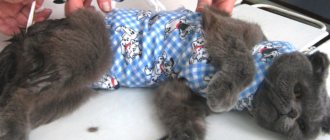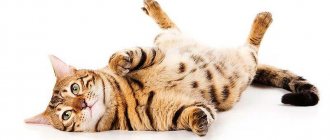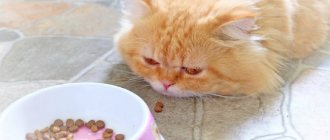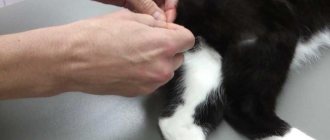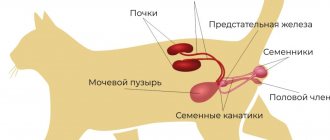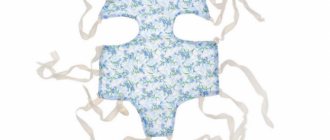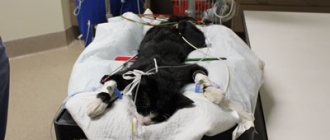9803Administration
Castration is an operation during which the testes are removed from cats, after which the animal does not experience sexual attraction to females. Castration is carried out under anesthesia, and animal owners are interested in the question: “How long does it take a cat to recover from anesthesia after castration?”
Even a veterinarian cannot give an unambiguous, accurate answer to this question, because it depends on the age and individual characteristics of his body. The older he is, the longer it will take to recover from anesthesia, so it is advisable to castrate your pet at a young age.
On average, a cat recovers from anesthesia after castration from 2 to 12 hours.
Young and active animals begin to try to stand up and crawl within a couple of hours, while calmer pets can lie motionless for several hours. With the correct calculation of the drug for the animal, the pet will recover from anesthesia in 2-8 hours, but if it does not try to move for more than 8 hours, it is necessary to consult the doctor who performed the castration. For cats, they do not use ordinary anesthesia, but special drugs, under the influence of which their sensitivity is reduced, but their eyes remain open.
© shutterstock
How long does it take for a cat to recover from anesthesia?
The operation is performed in a clinic or at home. The animal's behavior seems strange in the first 5 or 6 hours after anesthesia. You can't leave him alone. At this time, the anesthetic effect ends and the animal’s postoperative sutures begin to hurt.
Urinary incontinence occurs, but this phenomenon is temporary and passes quickly. The pet's behavior returns to normal within one or two days. The exact time of residual effect of narcotic substances depends on the type of anesthesia, age and other individual characteristics of the animal. During this period, the pet needs the care of the owner.
What kind of anesthesia is given?
Castration of a cat is considered one of the simplest surgical interventions in veterinary practice. Mostly veterinarians resort to weak anesthesia. A medication is used that reduces the sensitivity of the pet for a certain period. It often takes 10 to 30 minutes for a cat to fall asleep quickly after administering the medicine. This time is directly related to the individual characteristics of a particular cat. The dosage of the medication is calculated by the veterinarian depending on the kitten’s body weight and age. According to data, animals that have a red coat are more resistant to anesthesia than cats with a different coat color, so they are often given a larger dose of pharmaceuticals.
How cats recover from anesthesia after castration - features of the condition
The process of recovery from anesthesia is individual. Some pets behave aggressively, others wake up slowly and remain lethargic for a long time. An inexperienced pet owner runs the risk of being bitten or scratched.
The side effect of drugs is prolonged disorientation in space and impaired coordination of movements. To prevent the consequences of physical activity, the cat is placed in a place from which it cannot fall. The best option is to leave it in a carrier for a while, in a warm, dry place without drafts and away from heating radiators.
Be sure to read:
How to care for a cat after sterilization: blanket, diet, treatment and removal of sutures
The nuances of castration of older cats
If the owner decides to undergo surgery on a pet that is more than three years old, a number of points should be taken into account:
- Castration is performed only under general anesthesia. Local anesthesia at this age is not effective and can cause painful shock.
- Adult cats recover from anesthesia quite difficult, and therefore the owner should be attentive to the condition of the pet.
- Preparation for the operation is required, which includes blood and urine testing. This allows you to determine whether the animal has chronic diseases.
- It is also worth conducting an allergy test to identify a reaction to anesthesia.
How to behave when a cat recovers from anesthesia, what to do?
The first three days of the pet should not be lost sight of. You need to monitor the healing process and do not let the cat lick the wound. Otherwise, infection and purulent inflammation are possible. To prevent licking, wear an Elizabethan collar. The seams are treated with products recommended by the veterinarian. If the cat quickly came to his senses, the wounds do not bother him, and they should not be treated again.
Clean water should be nearby at all times. If the animal wants to drink, but cannot do it, you need to wet the mouth with a syringe or pipette, but do not inject it forcibly. You cannot feed your pet on the first day.
An empty tray without filler is placed next to the convalescent person so that the animal does not clog the wound. The toilet should be cleaned daily, or even better after each visit. If the first bowel movements do not occur in the tray, there is no need to punish. It may be painful for a cat to climb. When the condition returns to normal, the habit of going to the toilet will be restored.
If a cat is soiled with urine, it should not be bathed. You should use refreshing wipes.
What is it and how is it done?
Before considering how cats tolerate castration and other nuances of the intervention, we should dwell on the definition and types of manipulation.
During the procedure, the male’s testes are not simply removed, as is commonly thought, but the animal’s sexual function is also stopped, so different methods are used:
- Surgical method - performed through surgery. During it, the doctor opens the animal’s scrotum, removes the testes and ligates the canals.
- Medical sterilization. An implant is sewn under the animal’s skin, releasing drugs that suppress sexual instincts. The procedure is expensive, but is considered the safest.
- Chemical castration. In this case, substances are introduced into the testes that kill glandular tissue, which is subsequently replaced by connective tissue.
- Radiation sterility. In this case, the testes are placed under a source of gamma radiation. The method is quite simple, but the appropriate equipment is rarely found in clinics.
So, not every case requires a scalpel. The available choice of methods allows you to sterilize even old pets without risking their health and life. The veterinarian decides which castration is best for a cat, taking into account the age, health status of the animal and the capabilities available at the clinic.
In our country, they most often resort to the classical method of surgery. The reasons for this are the simplicity and cost-effectiveness of the technique. Let's dwell on it in more detail.
Cat after anesthesia: 6 signs that should alert the owner
A conscientious owner takes a vacation while caring for a neutered cat. Despite the simplicity of the operation, your pet may experience complications for a number of reasons.
The following are symptoms that may require veterinary attention:
- Low or high body temperature. The norm for cats is from 37.5 to 39.0 °C. The veterinary surgeon who performed the operation will tell you how often you need to measure your temperature. The problem is that anal measurement is painful. Therefore, purchase an ear or non-contact thermometer. The costs will pay off, since the need for thermometry will arise more than once during your life.
- Refusal to drink for a day and food for more than three days. If the cat does not drink, the concentration of salts in the urine will increase, which can lead to sedimentation and the onset of urolithiasis. Some cats may go 3 or more days without drinking when fed wet, prepared, canned food or natural food. But after the operation, a day is considered an acceptable period. Perhaps refusal to drink indicates intoxication, in which vomiting occurs when food or water enters the stomach. A healthy cat can go without food for 5 days. But, for the speedy healing of wounds, the operated pet needs nutrients. On the second day, a third of the feed is given from the norm, and at the end of the week the consumption is brought up to the recommended value.
- Stiffness in movements due to a feeling of interference in the perineum. This may be due to swelling of the sutures, but it is dangerous to act at your own risk.
- Pain when stroking the abdomen. Probably, the infection entered the abdominal cavity during the operation, or after it with a sudden movement, peritonitis develops
- Painful and difficult urination , accompanied by a plaintive meow.
- Dehiscence of the suture, bleeding for 2-3 days or the appearance of purulent discharge.
Be sure to read:
After sterilization, the cat does not eat or drink for several days: what to do, what to feed
Difference between sedation and anesthesia in cats
Many people confuse sedation with anesthesia. Although they are related, they refer to different stages of sensory loss. These:
- Local anesthesia : sensation is lost only in a specific part of the body, but otherwise the animal remains conscious.
- Sedation : This is when a cat's central nervous system is suppressed, preventing the animal from feeling pain without losing consciousness.
- General anesthesia : suppress the central nervous system to such an extent that the cat feels no sensation and becomes completely unconscious.
© shutterstock
The type of anesthesia your cat will receive depends on the type of surgery. If the surgery is invasive, general anesthesia will likely be required. However, this will be determined by the veterinarian during the pre-anesthesia examination. This is an assessment to understand the cat's clinical picture and overall health. They will check:
- Complete medical history (existing diseases and medications)
- Physical examination (vital signs, mucous membranes, capillary refill time and body condition)
- Blood test and biochemistry
- Analysis of urine
- Electrocardiogram to assess heart condition
- In some cases, x-ray or ultrasound
How long can a cat have a fever after castration?
After castration, as after any surgical intervention, it is necessary to monitor body temperature. In the first hours it may drop below 37 °C. This is explained by stress, blood loss, and slowing of metabolism under the influence of anesthesia. The cat may shiver, so it should be well wrapped.
The advice to cover your pet with heating pads is questionable, as it promotes bleeding. The temperature should return to normal within 24 hours. If hypothermia continues for the second day, you should inform your veterinarian.
But, on the first day the temperature can rise to 40 °C. If no other pathological symptoms are noticed, there is no need to worry. But when a pet has a fever 4 or more days after surgery, veterinary care is necessary: an inflammatory process develops. You should not give your cat antipyretic medications, since their effect on humans and cats is different.
Dangerous consequences
An animal should definitely be taken to the vet if it produces blood when trying to urinate.
It is important for the owner to monitor the condition of the animal. The following conditions are considered unsafe:
- a serious increase or decrease in body temperature;
- change in heart rhythm;
- immobility for more than 12 hours after surgery;
- lack of pupillary reaction to light;
- severe vomiting that lasts more than 24 hours;
- constipation for 3 days;
- pain during bowel movements;
- presence of blood impurities in urine;
- discharge of pus from wounds.
How does the character of castrated cats change?
Almost all cat owners whose pets have undergone removal of the testes note how much the character of their pets has improved. Of course, if the cat was affectionate and gentle before the operation, he will remain so after it. But aggressive specimens, on the contrary, become much calmer, balanced and flexible. If previously communication with the owner was limited only to bites and scratches, then after castration such a cat can be petted almost without fear.
Castration does not affect the character of a young animal operated on at an early age. The cat will remain as playful and cheerful as it was before the operation, and, what is especially pleasant, will retain this character trait until old age. All that is required from the owners is to take part in his endless games and pranks or get him a companion - not necessarily a cat!
The situation is different with animals that were castrated at a fairly mature age, whose character has had time to fully develop. After castration, they become too phlegmatic for active games, preferring to spend time in a blissful slumber, basking in the sun or curling up in a secluded corner. Such cats, whose body does not receive enough physical activity, may develop problems with the heart and joints, especially if they are overweight. This especially often affects cats of the British breed, whose phlegmatic nature has become the talk of the town. To maintain the health of your pet, try at every opportunity to stir him up and involve him in a fun game. And when the weather permits, put a harness on him and go for a walk. It will benefit both him and you!
What is anesthetic risk?
No matter how experienced the surgeon and anesthesiologist are, there is always the possibility of complications, even death. Anesthesia for cats is a serious burden primarily on the cardiovascular and respiratory systems. Minimizing anesthetic risks is the task of the veterinarian, who is obliged to individualize the standard regimen taking into account the characteristics of a particular cat. In many cases, the serious condition of a cat after anesthesia is a consequence of the use of drugs “at random”, without studying the condition of the mustachioed patient. To avoid problems, it is important to contact only competent specialists with an excellent reputation.
Types of anesthesia for dogs and drugs
Inhalation
With this method of pain relief, drugs enter the pet’s body through a special mask or tube directly into the respiratory system. Next, we will consider the pros, cons and possible consequences of gas anesthesia for dogs.
Pros:
- instantly putting the patient to sleep;
- after stopping the drug administration, the pet quickly wakes up.
Minuses:
- the most expensive method of anesthesia, as it requires special equipment and personnel training;
- has virtually no analgesic effect.
Preparations:
- isoflurane;
- sevoflurane.
Intravenous
Currently, intravenous anesthesia is the most common type of anesthesia in the treatment of pets. The method involves administering drugs through a vein and putting the animal into deep sleep.
Pros:
- a fairly economical method; drugs for intravenous anesthesia are available in any veterinary clinic;
- suitable for both quick and long-term operations, since the dose of drugs is easy to regulate;
- allows for maximum pain relief for your pet.
Minuses:
- possible decrease in body temperature;
- possible decrease in pressure;
- convulsions may occur upon awakening.
Preparations:
- acepromazine;
- opioids;
- diazepam;
- propofol;
- gilded;
- medetomidine;
- ketamine.
Local anesthesia
Local anesthesia includes a wide range of different types of anesthesia - from the simplest application (an anesthetic drug is applied to the skin without an injection) to epidural anesthesia, which is used as an additional method of pain relief during surgery on the hind limbs, sterilization, etc. The principle of this type of anesthesia consists in blocking the conduction of nerve impulses coming from a specific nerve.
Pros:
- allows you to significantly reduce the dose of intravenous anesthesia or not use it at all (for simple operations);
- allows operations to be performed on patients for whom intravenous anesthesia is contraindicated.
Minuses:
- damage to the nerve and surrounding tissues is possible if pain relief is performed incorrectly;
- possible bleeding and hematoma formation at the injection site;
- risk of infection entering the spinal canal;
- the risk of developing urinary disorders after epidural anesthesia.
Preparations:
- Lidocaine;
- Bupivacaine;
- Ropivacaine.
Important Takeaways
Some operations are performed only once in a lifetime (sterilization of a dog, sterilization of a cat, castration of a male or female cat), so let this surgical intervention be carried out in excellent conditions and with fully controlled anesthesia.
Take the time to find a veterinary clinic that offers gas anesthesia, and don’t skimp on traveling if the chosen facility is far from you. It's worth it!
Easy awakening after inhalation anesthesia
And if any procedure (for example, brushing teeth) or surgery (for injuries and other pathologies) must be performed more than once for forced reasons, then choosing inhalation anesthesia at some point may simply save the life of your cat or dog.
Abnormal stool
After surgery, the cat's intestinal function may be disrupted and constipation or diarrhea may appear, which is accompanied by pain and brings additional suffering to the animal. You need to pay attention to the following signs:
- refusal to eat;
- plaintive meow;
- absence of acts of defecation;
- periodically appearing trembling of the back of the body.
If your cat is constipated, you need to purchase a laxative for her on the recommendation of a veterinarian and change her diet. At home, you can use regular Vaseline.
Diarrhea occurs after exposure to toxins contained in anesthesia . In this case, the cat should limit drinking and feeding and use medication prescribed by the veterinarian. At home you can drink rice water.
© shutterstock
Care instructions
Important symptoms to watch out for after surgery:
- temperature (if it rises, then this is a serious signal);
- refusal of water and food for more than a day;
- lethargy/apathy for a long time;
- rapid heartbeat and shortness of breath;
- difficulty urinating, lack of bowel movements;
- purulent discharge from the wound.
As long as the cat leaves after castration, he should remain in constant view for as long. We'll give you some advice on care immediately after you bring your animal home.
How to feed?
Pets may not only refuse to eat on their own, but also experience symptoms of nausea and vomiting. This is indicated by frequent licking. The vomit contains foam, bile, and mucus. Additionally, convulsions and excessive salivation may occur. It is better to give only water at first.
Your veterinarian will prescribe a detailed diet for you. Usually, you need to feed a cat after castration every other day (6-24 hours). It is better to give the usual semi-liquid food in small quantities (1/3 of the usual norm). Fractional feeding is required to prevent stomach upset.
Approximately 5-7 days after complete recovery, you can switch to new food for sterilized cats. Consult with a specialist which one is best to choose. After surgery, the animal needs vitamins and a special diet according to its age, as changes occur in hormonal levels. He may eat more than usual and gain weight. Feeding from the table is completely contraindicated! This must be monitored so as not to harm the health of the pet.
What to do if your cat is marking his territory?
Owners of cats, and not only neutered ones, often complain about this problem. You must be prepared for the fact that surgery is a huge stress for the animal. In addition, some of them still have reflexes for reproduction and high levels of sex hormones. Gradually their number should decrease - after 3-4 weeks.
Other reasons for the tag include:
- sexually mature age;
- old habit;
- cryptorchidism;
- diseases of the urinary system, etc.
If more than a month has passed and the cat is marking its territory after castration and does not want to give up its habit, contact a veterinarian or animal psychologist.
The main advice is not to scold the four-legged dog, on the contrary, give it more attention and care. Try changing the tray more often, and also use special products that scare animals away from the tag.
What to do if a cat licks its wounds?
After the operation, veterinarians dress the cats in special blankets and collars. They protect the animal from the desire to lick and scratch.
After castration, a cat may deliberately show its dissatisfaction with the new “clothes”: walk backwards or refuse to move at all in them. The collar prevents them from orienting themselves in space, eating and drinking. He can touch the corners with it and try with all his might to get rid of it.
During this period, under no circumstances allow your pet to remove the equipment on its own. It can cause infection, which will lead to swelling, inflammation and a longer recovery period. Maintain the cleanliness, integrity of the bandage and the overall comfort of the animal in it.
After surgery, daily care and suture checking are required. Treatment of wounds is carried out by the owner independently, at home. If for some reason the animal does not allow you to do this, then veterinarians will handle it.
For the procedure, use antiseptic preparations without alcohol, for example, chlorhexidine (0.05% aqueous solution) or dioxidine (0.5%). After this, the seams are usually lubricated with levomekol ointment, and a small bandage/cotton pad is applied on top. During this procedure, it is better not to remove the bandage completely, but only to open the required area.
If you notice pustular inflammation or bloody smudges, this is a bad sign. See your doctor immediately.
Consequences and side effects
The drug is safer than many of its previously used analogues. However, it also has accompanying actions. Side effects of Propofol include:
- arterial hypotension (low blood pressure),
- bradycardia (slow heart rate),
- depression of respiratory function (up to short-term apnea).
In rare cases, convulsions, allergic reactions may occur, and after waking up - nausea, vomiting, and headache. The vast majority of patients have a completely normal reaction to Propofol.
To minimize side effects, a doctor should prescribe Propofol based on preliminary tests, which should determine how safe the use of this drug is for a particular patient.
In addition, constant monitoring of the patient’s condition under anesthesia and the availability of resuscitation equipment in the clinic, incl. apparatus for artificial ventilation of the lungs.
Propofol can only cause harm if the permissible dosage is exceeded. But provided that the drug is prescribed correctly and the anesthesiologist is equipped with all the means necessary for control, the occurrence of such a situation is excluded.
First hours
The first days of the postoperative period are considered critical, during which the owner must monitor the cat’s condition. When you arrive home, you need to place your pet on the floor in a quiet place, away from heating radiators and drafts. You should not place a sleeping cat on the bed; it may fall and hurt itself.
Typical cat behavior after anesthesia is a cocktail of mixed negative emotions. Gradually coming to its senses, the cat looks deeply unhappy, constantly tries to go somewhere, staggers, has difficulty holding its head up, crashes into walls, and cannot get into the doorway. It’s painful and scary to watch, your heart aches with pity, but it’s important to pull yourself together and realize that all this is the norm. Until muscle tone is restored, you need to hold your pet, not allowing it to wander around the apartment or jump on the furniture: affection, quiet conversations and light stroking will certainly help, unless the pet shows aggression.
Sudden aggression in a cat after anesthesia is also normal. The pet is disoriented, her paws do not obey her, it is difficult to concentrate, calculate the distance, and it is difficult to assess the situation as a whole. The cat is frightened, tries to climb higher or hide deep under the bed, and the owner not only does not allow her privacy, but also constantly climbs with a thermometer, feels her nose, ears, and intrudes in every possible way. How can you not get angry? To reduce emotional pressure, you should close the curtains, ask your family to be quieter and once again not approach the cat, observing its actions from the side.
